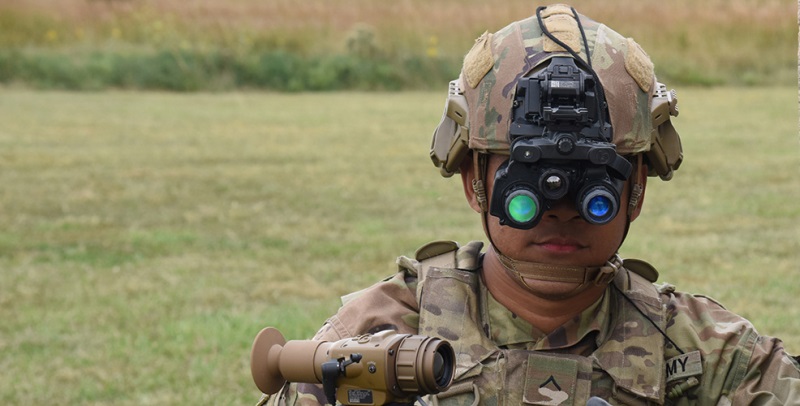
The role of night vision equipment in the military
What is night vision equipment and how does it work?
Night vision equipment works by collecting the available light from the visible portion of the electromagnetic spectrum, as well as some infrared radiation, and presenting those images to the operator. In low-light conditions, some standard night vision equipment can amplify existing light up to 500 times. Image intensification is a type of optical device that increases available ambient lighting so the user will be able to see with little or no additional illumination. Many first generation night vision devices were active, meaning they used a built-in illuminator using infrared technology to brighten up dark scenes. Second generation night vision technology contains an automatic brightness control known as Automatic Light Exposure (ALE). ALE automatically adjusts the gain of a night vision device according to incoming signal strength thereby providing effective visibility in a variety of ambient light conditions. While first generation night vision devices are active, second generation devices are passive. Passive night vision devices do not have a built-in illuminator and instead rely on existing light such as moonlight or starlight to see images in darkness.
How is night vision technology changing?
A third generation of military night vision technology uses solid state image intensification that uses semiconductors, photodetectors, and an ion barrier film instead of the vacuum tube required by old-style night vision goggles. Fourth generation active infrared night vision employs integrated circuitry from silicon micro-chip manufacturing to integrate the electronics needed for infrared imaging into one device which can provide both thermal imaging and standard day/night imaging.
Fourth generation night vision devices with thermal imaging capabilities are currently undergoing rapid development and are beginning to be fielded in some units.
What role do night vision devices play in the military?
Military forces need night vision equipment for two primary purposes: navigation and target acquisition. For example, using night vision goggles during raids at nighttime provides soldiers with a tactical advantage over their opponents. Navigation is also easier because users can see where they are going without extra illumination or awkward head lamps that make movement difficult. Target acquisition is essential to any combat operation, especially when the opposing force uses the cover of darkness as a tactical advantage. This means that soldiers can identify potential threats before they become engaged in battle. Acquisition of targets can also take place during reconnaissance missions, covert operations, and search and rescue operations.
What are the benefits of night vision technology?
Night vision devices make it easier to conduct military operations at night because soldiers do not have to rely on artificial light sources or infrared illumination. They can see their surroundings using ambient light alone which helps them navigate without falling off cliffs or stumbling into ditches. Soldiers operating in darkness need only worry about navigation and acquisition instead of worrying about illumination. This allows for more efficient battlefield management which reduces fatigue by giving troops longer periods of rest between missions than if they were fighting during the day when sunlight illuminates activity on the ground. Night vision devices help increase the nighttime operational efficiency of aircraft and other vehicles such as ships, tanks, and submarines. Night vision devices also help to reduce fratricide during night battles.
What are some considerations about night vision equipment?
Wearing night vision goggles or monoculars is a physical challenge for many users who must deal with limited peripheral and distance vision and increased weight. To accommodate these issues and improve military performance at night, new technology is being developed that integrates multiple sensors into one device so soldiers can acquire information quickly without removing their goggles or binoculars. Soldiers may experience eyestrain from using night vision devices because the image is projected across the entire retina opposed to working as a magnifying glass like binoculars. Weapons of higher caliber with increased muzzle velocity and kinetic energy can damage night vision devices and render them useless, especially if the soldier wearing them is hit by a round or fragments from an explosion. This reduces the ability to acquire targets at night and also limits combat survivability for that soldier because he cannot see his immediate surroundings.